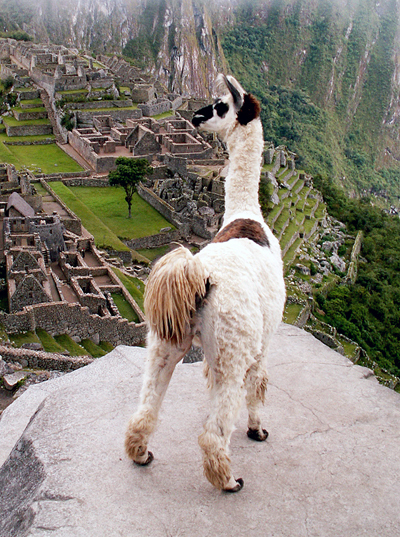- Lama (genus)
Taxobox
name = Llamas

image_width = 250px
image_caption =Llama
regnum =Animal ia
phylum =Chordata
classis =Mammal ia
ordo =Artiodactyla
familia =Camelidae
genus = "Lama"
subdivision_ranks =Species
subdivision = "Lama glama" "Lama guanicoe""Lama" is the modern
genus name for two South Americancamelid s, the wild guanaco and the domesticated llama. This genus is closely allied to the wild vicuña and domesticated alpaca of the genus "Vicugna". Before the Spanish conquest ofthe Americas , llamas and alpacas were the only domesticatedungulate s of thecontinent . They were kept not only for their value as beasts of burden, but also for their flesh, hides, andwool . See individual species articles at:*
Llama
*Guanaco
*Alpaca (Currently "Vicugna pacos", formerly "Lama pacos")
*Vicuña (Closely related "Vicugna vicugna")Classification
Although they were often compared by early writers to sheep and spoken of as such, their affinity to the camel was soon perceived. They were included in the genus "
Camelus " in the "Systema Naturae" of Linnaeus. In1800 , Cuvier moved the llama, alpaca and guanaco to the genus "Lama", and the vicuña to the genus "Vicugna ". Later, the alpaca was also transferred to "Vicugna". These camelids are, with the two species of truecamel s, the sole existing representatives of a very distinct section of theArtiodactyla or even-toed ungulates, calledTylopoda , or "hump-footed," from the peculiar bumps on the soles of their feet. This section thus consists of a single family, theCamelidae , the other sections of the same great division being the "Suina " orpig s, the "Tragulina" orchevrotain s, and the "Pecora" or trueruminants , to each of which the "Tylopoda" have more or less affinity, standing in some respects in a central position between them, borrowing as it were some characters from each, but in others showing great special modifications not found in any of the other sections.Discovery of the extinct fauna of the American continent of the
Tertiary period, starting with the palaeontologists Leidy, Cope, and Marsh, has revealed the early history of this family. It is now known that llamas were not always confined to South America; their remains are abundant in thePleistocene deposits of theRocky Mountains region, and inCentral America ; some of these extinct forms were much larger than any now living.None of these transitional forms have been found in Old World strata; it is therefore clear that
North America was the original home of the Tylopoda, and that the true camels passed over into the Old World by way of northAsia . Gradually driven southward, perhaps by changes ofclimate , and having become isolated, they have undergone further special modifications. Meanwhile, the other surviving members of the family have become restricted toSouth America .Characteristics
The following characters apply especially to llamas.
Dentition of adults:-incisors 1/3 canines 1/1, premolars 2/2, molars 3/2; total 32. In the upper jaw there is a compressed, sharp, pointed laniariformincisor near the hinder edge of thepremaxilla , followed in the male at least by a moderate-sized, pointed, curved true canine in the anterior part of the maxilla. The isolated canine-likepremolar which follows in the camels is not present. The teeth of the molar series which are in contact with each other consist of two very small premolars (the first almost rudimentary) and three broadmolars , constructed generally like those of "Camelus". In the lower jaw, the three incisors are long, spatulate, and procumbent; the outer ones are the smallest. Next to these is a curved, suberect canine, followed after an interval by an isolated minute and often deciduous simple conical premolar; then a contiguous series of one premolar and three molars, which differ from those of "Camelus" in having a small accessory column at the anterior outer edge.The skull generally resembles that of Camelus, the relatively larger brain-cavity and orbits and less developed
cranial ridges being due to its smaller size. The nasal bones are shorter and broader, and are joined by thepremaxilla .Vertebrae :
* cervical 7,
* dorsal 12,
* lumbar 7,
* sacral 4,
* caudal 15 to 20.Ears are rather long and pointed. There is no dorsal hump. Feet are narrow, the toes being more separated than in the camels, each having a distinct plantar pad. The tail is short, and fur is long and woolly.
The Llama and Alpaca are only known in the domestic state, and are variable in size and colour, being often white, black, or piebald. The Guanaco and Vicuña are wild and endangered, and of a nearly uniform light-brown colour, passing into white below. They certainly differ from each other, the Vicuña being smaller, more slender in its proportions, and having a shorter head than the guanaco. It may, therefore, be considered distinct. It lives in
herd s on the bleak and elevated parts of the mountain range bordering the region of perpetual snow, amidst rocks and precipices, occurring in various suitable localities throughoutPeru , in the southern part ofEcuador , and as far south as the middle ofBolivia . Its manners very much resemble those of thechamois of theEuropean Alps ; it is as vigilant, wild, and timid. The wool is extremely delicate and soft, and highly valued for the purposes of weaving, but the quantity which each animal produces is minimal.The Guanaco has an extensive geographical range, from the high lands of the Andean region of Ecuador and Peru to the open plains of
Patagonia , and even the wooded islands ofTierra del Fuego . It constituted the principal food of the Patagonian Indians, and they use its skin for the material out of which their long robes are constructed. It is about the size of aEuropean red deer , and is an elegant animal with a long, slender, gracefully curved neck and slim legs.External
* A German llama-homepage with a lot of pictures and informations : http://www.Sylt-Lamas.de
Wikimedia Foundation. 2010.
